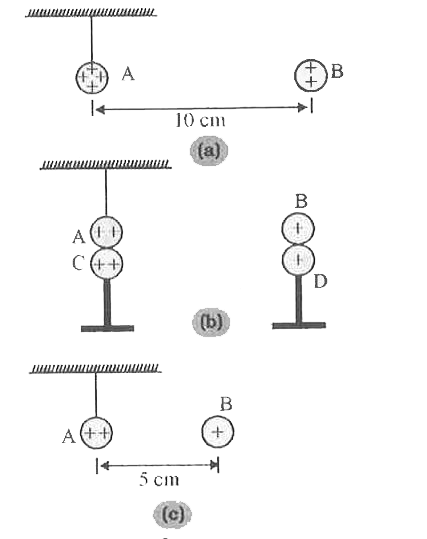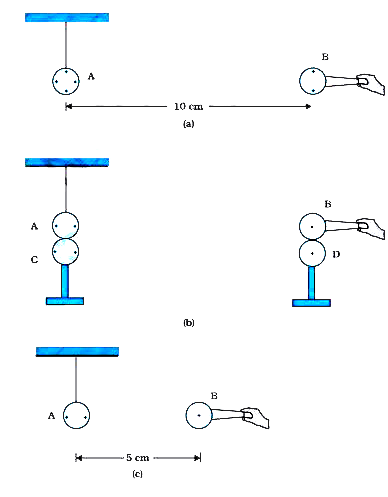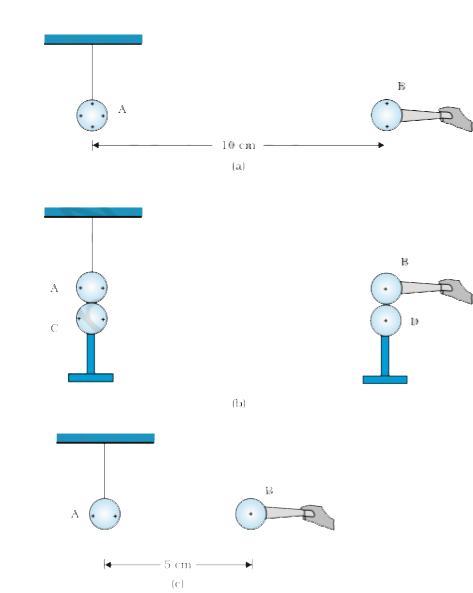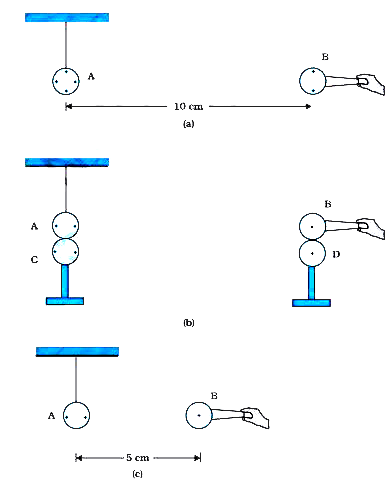A charged metallic sphere A is suspended by a nylon thread. Another charged metallic sphere B held by an insulating handle is brought close to 'A' such that the distance between their centres is 10cm as shown in the figure (a). The resulting repulsion of A is noted (for example, by shining a beam of light and measuring the deflection of its shadow on a screen). Spheres A and B are touched by uncharged spheres C and D respectively as shown in the fig (b). C and D are then removed and B is brought closer to A to a distance of 5.0cm between their centres as shoen in the fig(c). What is the expected repulsion of A on the basis of Coulomb's law? Spheres A and C and spheres B and D have identical sizes. Ignore the sizes of A and B in comparison to the separation between their centres.
'(##VPU_HSS_PHY_XII_CO1_E01_005_Q01##)'Solution in Malayalam
Step by step video & image solution for A charged metallic sphere A is suspended by a nylon thread. Another charged metallic sphere B held by an insulating handle is brought close to 'A' such that the distance between their centres is 10cm as shown in the figure (a). The resulting repulsion of A is noted (for example, by shining a beam of light and measuring the deflection of its shadow on a screen). Spheres A and B are touched by uncharged spheres C and D respectively as shown in the fig (b). C and D are then removed and B is brought closer to A to a distance of 5.0cm between their centres as shoen in the fig(c). What is the expected repulsion of A on the basis of Coulomb's law? Spheres A and C and spheres B and D have identical sizes. Ignore the sizes of A and B in comparison to the separation between their centres. '(##VPU_HSS_PHY_XII_CO1_E01_005_Q01##)' by Physics experts to help you in doubts & scoring excellent marks in Class 12 exams.
Similar Questions
धातु का आवेशित गोला A नायलॉन के धागे से निलंबित है। विद्युतरोधी हत्थी द्वारा किसी अन्य धातु के आवेशित गोले B को A के इतने निकट लाया जाता है कि चित्र (a) में दर्शाए अनुसार इनके केंद्रों के बीच की दूरी 10cm गोले के परिणामी प्रतिकर्षण को नोट किया जाता है (उदाहरणार्थ-गोले पर चमकीला प्रकाश पुंज डालकर तथा अंशांकित पर्दे पर बनी इसकी छाया का विक्षेपण मापकर)। A तथा B गोलों को चित्र (b) में दर्शाए अनुसार क्रमशः अनावेशित गोलों C तथा D से स्पर्श कराया जाता है। तत्पश्चात् चित्र (c) में दर्शाए अनुसार C तथा D को हटाकर B को A के इतना निकट लाया जाता है कि इनके केंद्रों के बीच की दूरी 5.0 cm हो जाती है। कूलॉम नियम के अनुसार A का कितना अपेक्षित प्रतिकर्षण है? गोले A तथा C एवं गोले B तथा D के साइज सर्वसम हैं। A तथा B के केंद्रों के पृथक्कन की तुलना में इनके साइजों की उपेक्षा कीजिए।
 06:27View Solution
06:27View SolutionA charged metallic spere A is suspended by a nylon thread another charged metallic spere b held by an insulating centres is 10 cm c and d are then removed and b is brought closer to a to a what is txpectd repulsion of a on the basis of columb law sphere a and c speres b and d have indentical sizes ignore the sizes of a and b in comparision to the separation between their centres
 View Solution
View SolutionA charged metallic sphere A is suspended by a nylon thread another charged metallic sphere b held by an insulating centers is 10 cm as shown in Fig. 1.7(a). The resulting repulsion of A is noted (for example, by shining a beam of light and measuring the deflection of its shadow on a screen). Spheres A and B are touched by uncharged spheres C and D respectively, as shown in Fig. 1.7(b). C and D are then removed and B is brought closer to A to a distance of 5.0 cm between their centers, as shown in Fig. 1.7(c). What is the expected repulsion of A on the basis of Coulomb’s law? Spheres A and C and spheres B and D have identical sizes. ignore the sizes of a and b in comparison to the separation between their centers
 04:24View Solution
04:24View SolutionA charged metallic sphere A is suspended by a nylon thread. Another charged metallic sphere B held by an insulating handle is brought close to A such that the distance between their centres is 10 cm, as shown in Fig. 1.7(a). The resulting repulsion of A is noted (for example, by shining a beam of light and measuring the deflection of its shadow on a screen). Spheres A and B are touched by uncharged spheres C and D respectively, as shown in Fig. 1.7(b). C and D are then removed and B is brought closer to A to a distance of 5.0 cm between their centres, as shown in Fig. 1.7(c). What is the expected repulsion of A on the basis of Coulomb’s law? Spheres A and C and spheres B and D have identical sizes. Ignore the sizes of A and B in comparison to the separation between their centres.
 04:07View Solution
04:07View SolutionA charged metallic sphere A is suspended by a nylon thread. Another charged metallic sphere B held by an insulating handle is brought close to A such that the distance between their centres is 10 cm, as shown in figure (a). The resulting repulsion of A is noted (for example, by shining a beam of light and measuring the deflection of its shadow on a screen). Spheres A and B are touched by uncharged spheres C and D respectively, as shown in figure (b). C and D are then removed and B is brought closer to A to a distance of 5.0 cm between their centres, as shown in figure (c). What is the expected repulsion of A on the basis of Coulomb's law ? Spheres A and C and spheres B and D have identical sizes. Ignore the sizes of A and B in comparison to the separation between their centres.
07:23View SolutionA charged metallic spere A is suspended by a nylon thread another charged metallic spere b held by an insulating centres is 10 cm c and d are then removed and b is brought closer to a to a what is txpectd repulsion of a on the basis of columb law sphere a and c speres b and d have indentical sizes ignore the sizes of a and b in comparision to the separation between their centres
 View Solution
View SolutionA metal sphere with its centre at A and radius R has a charge 2q on it. The field at a point B outside the sphere is E. If another metal sphere of radius 3R and having a charge -3q is placed with its centre at point B, find out the resultant electric field at a point mid way between A and B.
05:15View SolutionA metal sphere is suspended from a nylon thread. Initially, the metal sphere is uncharged. When a positively charged glass rod is brought close to the metal sphere, the sphere is drawn towards the rod. But if the sphere touches the rod, it suddenly flies away from the rod. Explain, why the sphere is first attracted then repelled?
04:49View Solution

